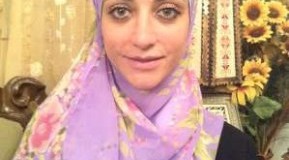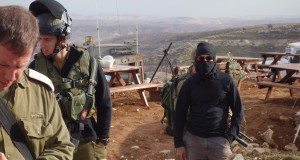28 June 2014 | International Solidarity Movement, Charlie Andreasson | Gaza, Occupied Palestine Yesterday, shortly after three o’clock local time, two men were killed in their car. Two missiles struck it only about 100 meters from former prime minister Ismail ...
Read More »No Jews allowed
5th June 2014 | International Solidarity Movement | Hebron, Occupied Palestine My plan for the morning was pretty simple, I wanted to enter the souq (market) and buy some bread for breakfast, and then walk home. That was it. As I ...
Read More »6 beds, ink and one story
25th May 2014 | Mariam Barghouti | Occupied Palestine Since 1967, Israel has detained around 20% of the Palestinian population and approximately 40% of Palestinian males. The majority of those arrested are transferred into Israel, where they are held and if charged will most ...
Read More »Video: Protest on World Press Freedom Day: “They don’t consider Palestinian journalists to be journalists.”
3rd May 2014 | International Solidarity Movement, Ramallah Team| Occupied Palestine Yesterday, Saturday 3rd of May was the United Nations World Press Freedom Day. Yesterday, journalists celebrated, remembered, and protested, on a date commemorated worldwide since 1992. In Palestine, the 3rd of May ...
Read More »Khan-al-Luban: Israeli army attack
20th April 2014 | International Solidarity Movement, Nablus Team| Khan al-Luban, Occupied Palestine On Monday 21 April 2014 two International Women’s Peace Service [IWPS] volunteers were playing uno [a card game] outside with two children of the Abu Jamal family in Khan al-Luban, ...
Read More »What will Gaza’s Ark face from the Israeli navy as it challenges the blockade?
17th April 2014 | International Solidarity Movement, Charlie Andreasson | Gaza, Occupied Palestine The heavy bang is heard clearly, and I have to resist the impulse to climb over the breakwater to try to get a view of the attack in ...
Read More »The fight for the freedom of the 5 Hares Boys continues
6th April 2014 | International Solidarity Movement, Nablus Team | Occupied Palestine In a conversation with Neimeh and Yaseen Shamlawi in their home in Hares we hear about the traumatic journey they have gone through but also the painstaking efforts they ...
Read More »“The reason is to wipe out Palestinian culture and history”: A Gaza carpet factory under siege
28th March 2014 | International Solidarity Movement, Charlie Andreasson | Gaza, Occupied Palestine Before we settle down for a glass of Turkish coffee among shelves filled with neatly stacked, woven carpets Mahmoud El Sawaf, 68 years old, shows me around the small factory. ...
Read More »Armed settlers occupy village land in Hebron
14th March 2014 | International Solidarity Movement, Team Khalil | Arab ar Rashyaida, Occupied Palestine On Tuesday 11th March 2014 villagers from Arab ar Rashyaida, 15 kilometers (10 miles) west of Hebron, noticed that a large tent and industrial digger had ...
Read More »Madleen Kolab, Gaza’s only fisherwoman
9th February 2014 | International Solidarity Movement, Charlie Andreasson | Gaza, Occupied Palestine I have seen her standing there more then once, at the edge of the port, looking out over the boats in the harbor and then towards the horizon. ...
Read More » International Solidarity Movement Nonviolence. Justice. Freedom.
International Solidarity Movement Nonviolence. Justice. Freedom.









